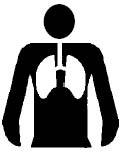Crystalline Silica Exposure in General Industry
Occupational Safety and Health Administration
U.S. Department of Labor
Health Hazard Information Card
- What is crystalline silica (quartz)?

The term "crystalline silica" and "quartz" refer to the same thing. Crystalline silica is a natural constituent of the earth's crust and is a basic component of sand and granite. - What is silicosis?
Silicosis is a disease of the lungs due to the breathing of dust containing crystalline silica particles. This dust can cause fibrosis or scar tissue formations in the lungs that reduce the lung's ability to work to extract oxygen from the air. There is no cure for this disease, thus, prevention is the only answer.
- What are the symptoms of silicosis?
There are several stages of silicosis. Early stages may go completely unnoticed. Continued exposure may result in the exposed person noticing a shortness of breath upon exercising, possible fever and occasionally bluish skin at the ear lobes or lips. Silicosis makes a person more susceptible to infectious diseases of the lungs like tuberculosis. Progression of the disease leads to fatigue, extreme shortness of breath, loss of appetite, pain in the chest, and respiratory failure, which all may lead eventually to death. Acute silicosis may develop after short periods of exposure. Chronic silicosis usually occurs after 10 or more years of exposure to lower levels of quartz.
- Where are general industry employees exposed to crystalline silica dust?
The most severe exposures to crystalline silica result from sandblasting, which may be done to clean sand and irregularities from foundry castings, finish tombstones, etch or frost glass, or remove paint, oils, rust, or dirt from objects that will be repainted or treated. Other exposures to dust from sand occur in cement manufacturing, asphalt pavement manufacturing, and the foundry industry. Crystalline silica is used in the electronics industry and in manufacturing abrasives, paints, soaps, and glass. Calcined diatomaceous earth, which can contain crystalline silica, is used for filtration in food and beverage production.
- How is OSHA addressing exposure to crystalline silica-containing dust?
OSHA has established a Permissible Exposure Limit, or PEL, which is the maximum amount of airborne crystalline silica that an employee maybe exposed to during the work-shift. OSHA is also beginning a Special Emphasis Program to inform employers and employees about the occurrence and hazards of crystalline silica and ways to reduce exposure to the dust.
- What can employees do to limit their exposure to crystalline silica?
- Employers are required to provide and assure the use of appropriate controls for crystalline silica-containing dust. Be sure to use all available engineering controls such as blasting cabinets, water sprays, and local exhaust ventilation. Substitution of less hazardous materials can also be used.
- Be aware of the health effects of crystalline silica and that smoking adds to the damage.
- Know the work operations where exposure to crystalline silica may occur.
- Participate in any air monitoring or training programs offered by the employer.
- Use type CE positive pressure abrasive blasting respirators for sandblasting.
- For other operations where respirators maybe required, wear a respirator approved for protection against crystalline silica-containing dust. Do not alter the respirator in any way. Workers who use tight-fitting respirators cannot have beards/mustaches which interfere with the respirator seal to the face.
- If possible, change into disposable or washable work clothes at the worksite; shower and change into clean clothing before leaving the worksite.
- Do no eat, drink, use tobacco products, or apply cosmetics in areas where there is dust containing crystalline silica.
- Wash hands and face before eating, drinking, smoking, or applying cosmetics outside of the exposure area.
If you have any questions about any occupational health matter, feel free to ask us. Our job is to protect your health. For more information, contact your local or Regional OSHA office (listed in the telephone directory under United State Government - Department of Labor - Occupational Safety and Health Administration).

